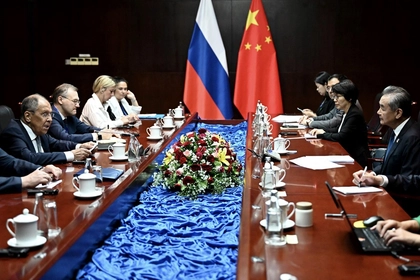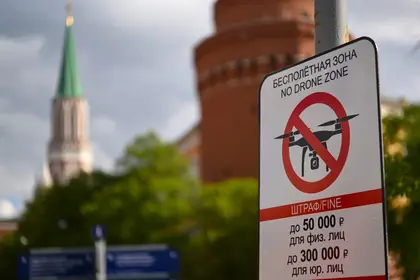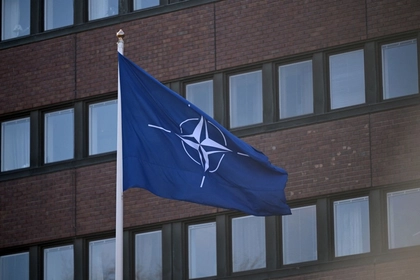During the early morning hours of May 3, a drone operated by an unknown actor was captured by surveillance cameras exploding over the dome of the Kremlin Senate – the palatial office of Russian President Vladimir Putin. While the physical damage to Moscow’s bastion of power was negligible, the psychological shockwaves now battering Russia are equally as far-reaching as the aftershocks that rippled throughout the Empire of Japan as a direct result of the daring Doolittle Raid on Tokyo in April 1942.
In the immediate aftermath of the Japanese surprise attack on Pearl Harbor and occupation of Wake Island in December 1941, United States President Franklin Roosevelt boldly embarked on an ambitious plan to strike back at the heart of Imperial Japan. The demonstration of American force was intended as a wakeup call to Japan and as a message of hope to the American people.
Then-Lieutenant Colonel James H. Doolittle did just that, leading a group of American aviators on a perilous one-way mission to bombard Japanese industry and infrastructure designed to “inflict material and psychological damage upon the enemy.” What seemed like an impossible task – launching 27,000-pound (12,000 kg) B-25 Mitchell bombers from the pitching deck of an aircraft carrier 1,000 kilometers east of Japan in the heavy seas of the Pacific Ocean – was accomplished through sheer determination, extensive training, preparation and heroic effort.

Russia, China FMs Meet as ASEAN Talks Get Underway in Laos
The raid’s results, forever immortalized in the classic 1944 wartime movie “Thirty Seconds Over Tokyo” starring Spencer Tracy as Doolittle, exceeded Washington’s expectations. Especially by providing the US public with a much-needed morale boost. Kyiv, similarly, nearly 80 years to the date of the Doolittle Raid, achieved the same “shot in the arm” effect after sinking of the Moskva – the flagship of Russia’s Black Sea fleet.
Regardless of who or what state actor was behind the game-changing drone attack on the Kremlin citadel, the strike, essentially, was Ukraine’s comparable Doolittle moment. It is achieving the same set of overarching goals, while also sending a loud message to Moscow’s elite population – heretofore safely hunkered down 750 kilometers away from Kyiv, that they are now in harm’s way. The drone’s modern-day “thirty seconds” over Moscow has set in motion a myriad of Russian responses, accusations – and potentially catastrophic divisive consequences for Putin in Bakhmut.
Moscow’s initial propaganda spin of the drone strike was to disingenuously accuse Ukraine of attempting to assassinate the Russian leader. Ukrainian President Volodymyr Zelensky, who was traveling in Finland at the time, promptly denied the far-fetched allegation, declaring “We are not attacking either Putin or Moscow, we are fighting on our own territory, we are defending our villages and cities.”
Zelensky’s scathing denial is far more plausible. The drone’s relatively small explosion over the Kremlin Senate failed to even damage the flagpole atop the dome. Given this, it is highly unlikely the drone could have penetrated the walls of the Kremlin, let alone kill or seriously harm Putin in his personal residence or office. In Putin’s Moscow, open windows would have had a higher probability of success.
Undeterred, Moscow then accused the Biden administration – without offering proof – of being behind Ukraine’s alleged assassination attempt on Putin. The Kremlin’s propaganda machinations were clear enough – reinforce allegations to the Russian public that Ukraine is a terrorist state, that with the backing of the US and NATO, is resorting to assassination to threaten Russia’s very existence. The whole “tale” however, is a little too scripted – and reminiscent of a “tail” wagging the dog.
Explanations for who, what, and the why of this drone strike abound. Many have a consistent theme: the removal or elimination of Putin. Ukrainian forces, partisan groups, or Russian conspirators all have a myriad of reasons as to desiring to remove or embarrass Putin and his ruling regime.
It is certainly possible this was a Ukrainian drone. If so, it was likely launched well inside of Russia, if not within the greater city limits of the capital given the massive amount of layered “electronic countermeasures” and air defenses deployed around Moscow since the beginning of Putin’s ‘special military operation’ in Ukraine. Kyiv’s proven propensity for adaptation, ingenuity, and resourcefulness has kept Putin and his generals off-balance for the past 15 months.
Ukraine has built long-range capacity and has struck deep inside Russia on multiple occasions – including drone strikes on the Engels-2 and Dyagilevo air bases. The latter is only 240 kilometers from the Kremlin. Zelensky, undoubtedly, has considered striking Moscow, but unless it was intended as a diversion for the upcoming Spring or Summer Ukrainian counteroffensive, it would have been best delivered early on in the war as was the Doolittle Raid.
The far more probable explanation is that the drone attack was a Russian “false flag” operation intended to generate public support for Putin’s war in Ukraine and subsequent troop mobilizations that to date are proving unpopular. The false flag is a standard play in the Russian playbook and, as such, a reliable predictor of future Russian activity.
In this instance, the objective would have been to create a ‘Russia is under attack’ scenario, thereby eliciting nationalistic response from the ‘proletariat’ to again – in the spirit of the upcoming Victory Day on May 9th – rise up and defend the Russian Motherland from an external threat.
The Kremlin “flyover” could very well be a well scripted ending to a possible Russian propaganda storyline of Ukrainian drone encroachment into the capital city. Notably, in February, an alleged Ukrainian drone was found in Kolomna, Russia, approximately 100 kilometerss from Moscow.
Then, in late April, yet another alleged Ukrainian drone was found in the Bogorodsky city district – only 30 kilometers from the Kremlin. The “discovery” of both drones led to the cancellation of Victory Day parades; however, it is possible this is just Russian disinformation to mask colossal “military losses” in hardware and in men.
Moreover, as if on cue, Russian state-controlled media pounced on these narratives and the Kremlin’s accusations against Zelensky and U.S. President Joe Biden. Julia Davis, a Russian media expert, pointed out that Vladimir Solovyov on his Russia 1 show, “blamed the Americans” and argued it should be used as a “pretext to kill Zelensky.” Further, while writing for the Daily Beast, Davis noted Solovyov absurdly compared the Kremlin drone attack to 9/11 even though “no one was injured.”
Russia’s propaganda clowns aside – chief among them, the ubiquitous RT broadcasting head Margarita Simonyan, who denied it was “a cunning plan by Moscow” – there are ominous factors to consider if indeed the Kremlin struck itself as a false flag. Russian demands for Zelensky’s assassination, use of tactical nuclear weapons in Ukraine, and/or renewed drone and cruise missile attacks similar to that of the US Operation Rolling Thunder – a massive bombardment that was intended to put military pressure on North Vietnam’s communist leaders and reduce their capacity to wage war against the US-supported government of South Vietnam.
Ukraine and NATO must be mindful of the words of the Kremlin: “Russia reserves the right to respond to an attempted strike on the Kremlin where and when it sees fit.” In fact, we are already seeing those words play out. An International Atomic Energy Agency report released on May 2, found that “Russian forces have located more weapons and explosives in and around the Zaporizhzhia nuclear power plant.” On May 3, Deputy Secretary of Russia’s Security Council, Dmitry Medvedev, brashly demanded the “physical elimination of Zelensky and his entourage.”
Moscow then launched a series of drone and missile strikes at Ukrainian cities on the evening of May 3 that lasted into the morning of May 4t. Ukraine’s Foreign Ministry said the barrage included 24 Iranian-made Shahed-136 and Shahed-131 kamikaze drones hitting Kyiv, Kherson, Odessa, and Zaporizhzhia in what was characterized as the largest attack of the year. Natalia Humeniuk, spokesperson for the Ukrainian military’s South Operational Command, noted the Russian drones bore recriminatory inscriptions, including notably “For Moscow” and “For the Kremlin.”
Significantly, at a far higher altitude, the fiery drone’s “thirty seconds” over Moscow is producing unintended consequences regardless of who orchestrated it. If it was a Russian-designed false flag, then, ironically, the drone strike is setting off serious Russian fissures stretching from the Kremlin to the bloodied streets and fields of Bakhmut.
Yevgeny Prigozhin is at war with Russian Defense Minister Sergei Shoigu over ammunition shortages – particularly artillery shells – and now the Wagner Group founder is threatening to withdraw his paramilitary forces from a city they have spent ten months vainly trying to capture.
Or, conversely, Prigozhin could have been behind the drone strike to embarrass Shoigu – and as payback for the unsolved assassination of Vladlen Tatarsky in a café owned by Prigozhin in St. Petersburg. Or some other Russian partisan group out to humiliate Putin. If so, that could explain why the Kremlin was quick to blame Zelensky and then the U.S. Essentially, anyone else versus admitting Putin is facing domestic upheaval.
It may be a long time before we know who was responsible for those “thirty seconds over Moscow,” however, we already know those thirty ticks of the clock have been game changing. Putin’s Russia, now more than ever, is divided. Moreover, false flag or not, Putin’s propaganda veneer that “all is well” is now off, and the citizens of Moscow now realize they are also in harm’s way.
Regardless of origin, the outcome – the effect, must be closely monitored. Russia has exploited the Kremlin drone incident to launch a physical and psychological pre-emptive strike against Ukraine’s much-anticipated counteroffensive. For good or for bad, this is Ukraine’s Doolittle moment.
If Zelensky’s generals pulled the Kremlin drone strike off, then mission accomplished. Russia is rattled.
If it was a Russian false flag, then Kyiv must remain mindful of its overarching purpose: to deter if not alter Ukraine’s looming counteroffensive – and be on guard if Putin uses it to justify taking the gloves off and attacking Ukraine with all assets available including tactical WMDs.
If it was Putin, then Kyiv must not be diverted from their overarching aim to expel Russian ground forces from all of Ukraine – including Crimea. If it was Prigozhin or some other Russian of like-kind, then Ukraine must be ready to exploit to the fullest the Russian divide – particularly Moscow’s now badly divided unity of command.
Zelensky is at his best when he forces Putin to react. If Ukraine was behind the drone strike on the Kremlin, then Putin will be left to wonder just where and how Kyiv pulled it off.
In that regard, if asked how, Zelensky would be wise to give the same coy answer Roosevelt did after the Doolittle Raid against Tokyo: Shangri-La.
Copyright 2023. Jonathan E. Sweet and Mark C. Toth. All rights reserved.
Jonathan Sweet, a retired Army colonel, served 30 years as a military intelligence officer. His background includes tours of duty with the 101st Airborne Division and the Intelligence and Security Command. He led the U.S. European Command Intelligence Engagement Division from 2012-14, working with NATO partners in the Black Sea and Baltics. Follow him on Twitter @JESweet2022.
Mark Toth is a retired economist and entrepreneur who has worked in banking, insurance, publishing, and global commerce. He is a former board member of the World Trade Center, St. Louis, and has lived in U.S. diplomatic and military communities around the world, including London, Tel Aviv, Augsburg, and Nagoya. Follow him on Twitter @MCTothSTL.
DISCLAIMER
The views expressed are the authors’ and not necessarily of Kyiv Post.
You can also highlight the text and press Ctrl + Enter






